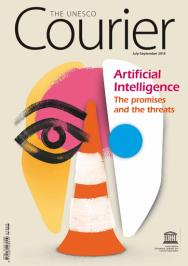مقال
الذكاء الاصطناعي: بين الأسطورة والواقع

هل يمكن للآلة أن تصبح أذكى من الإنسان؟ يرد جان غابريال غاناسيا: لا، هذه أسطورة مستوحاة من الخيال العلمي. ويستعرض المراحل الرئيسية للبحوث في هذا المجال، والبراعات التقنية الحالية والمسائل الأخلاقية التي تقتضي حلولا بصفة ملحّة.
بقلم جان-غابريال غاناسيا
الذكاء الإصطناعي هو نظام علمي بدأ رسميا في عام 1956 في كلية دارتموث في هانوفر بالولايات المتحدة الأمريكية، خلال انعقاد مدرسة صيفية نظمها أربعة باحثين أمريكيين: جون مكارثي، مارفن مينسكي، ناثانييل روتشستر وكلود شانون. ومنذ ذلك الحين، نجح مصطلح «الذكاء الاصطناعي» - الذي من المحتمل أن يكون قد اخترع في البداية لإثارة انتباه الجمهور - بما أنه أصبح شائعا لدرجة أن لا أحد يجهله اليوم، وأن هذا الفرع من المعلوماتية أخذ في الانتشار أكثر فأكثر مع مرور الوقت، وبما أن التقنيات التي انبثقت عنه ساهمت بقدر كبير في تغيير العالم على مدى الستين سنة الماضية.
إلّا أن نجاح مصطلح «الذكاء الاصطناعي» يرتكز في بعض الأحيان على سوء فهم عندما يشير إلى كيان اصطناعي موهوب بالذكاء، ومن ثم، قادر على منافسة الكائنات البشرية. هذه الفكرة التي تحيل إلى الأساطير والخرافات القديمة، مثل أسطورة غوليم، أُعيد إحياؤها مؤخرًا من قبل شخصيات معاصرة مثل الفيزيائي البريطاني ستيفن هوكنغ (1942-2018) أو رجل الأعمال الأمريكي إلون ماسك، و من قبل المفكر المستقبلي الأمريكي راي كورزويل أو أنصار ما يسمى اليوم «الذكاء الإصطناعي القوي» أو «الذكاء الإصطناعي العام». هذا ولن نستعمل في هذا المقال المعنى الثاني لأنه يشهد فقط على خيال مفعم، يستلهم من الخيال العلمي أكثر من الواقع العلمي الملموس الذي أثبتته الاختبارات والملاحظات التجريبية.
ومن وجهة نظر جون مكارثي ومارفن مينسكي، كما هو الحال بالنسبة للقائمين الآخرين على المدرسة الصيفية بكلية دارتموث، كان الذكاء الإصطناعي يهدف في البداية إلى محاكاة كل واحدة من مختلف قدرات الذكاء، بواسطة الآلات، سواء كان ذكاء بشريا أو حيوانيا أو نباتيا أو اجتماعيا أو تصنيفا تفرعيا حيويا. وقد استند هذا النظام العلمي أساسا إلى افتراض أن جميع الوظائف المعرفية، ولا سيما التعلّم، والاستدلال، والحساب، والإدراك، والحفظ في الذاكرة، وحتى الإكتشاف العلمي أو الإبداع الفني، قابلة لوصف دقيق لدرجة أنه يمكن برمجة جهاز كمبيوتر لاستِنساخها. ومنذ وجود الذكاء الاصطناعي، أي منذ أكثر من ستين سنة، ليس هناك ما يفند أو يثبت بشكل قاطع هذه الفرضية التي لا تزال مفتوحة وخصبة في آن واحد.
سجل تاريخي متباين
شهد الذكاء الإصطناعي العديد من التطورات خلال فترة وجوده القصيرة. ويمكن تلخيصها في ست مراحل.
• زمن الأنبياء
في بادئ الأمر، مع نشوة الإبتكار والنجاحات الأولى، انجرّ الباحثون في تصريحات مبالغ فيها نوعا ما، استُهدفوا على إثرها بانتقادات كثيرة. وعلى سبيل المثال، في عام 1958، صرّح الأمريكي هيربرت سايمون، الذي حاز في وقت لاحق على جائزة نوبل للاقتصاد، أنه في غضون عشر سنوات ستصبح الآلة بطلة عالمية في لعبة الشطرنج، إذا لم يتمّ استبعادها من المسابقات الدولية.
• السنوات المظلمة
بحلول منتصف الستينيات، تعثرت وتيرة التقدم. وتمكن طفل في العاشرة من العمر من التغلّب على جهاز كمبيوتر في لعبة الشطرنج عام 1965. وأشار تقرير أصدره مجلس الشيوخ الأمريكي سنة 1966 إلى القيود المتأصلة في الترجمة الآلية. فتعرّض الذكاء الإصطناعي لدعاية سلبية لمدة عشر سنوات.
• الذكاء الاصطناعي الدلالي
ورغم ذلك لم تتوقف البحوث، لكنها أخذت اتجاهات جديدة. وانصب الاهتمام على علم النفس المتعلق بالذاكرة وعلى آليات الفهم لمحَاولة محاكاتها على الكمبيوتر، كما تم الاهتمام بدور المعرفة في التفكير المنطقي. وهذا ما أدى إلى ظهور تقنيات التمثيل الدلالي للمعارف التي تطورت إلى حد كبير في منتصف السبعينات، والتي أدت أيضًا إلى تطوير ما يسمى بالنظم الخبيرة - سمّيت كذلك لأنها قد تتطلب استخدام معرفة خبراء مهنيين لاستنساخ طريقة تفكيرهم. وقد أثارت هذه النظم آمالًا كبيرة في أوائل الثمانينات بفضل التطبيقات المتعددة التي تم انتاجها، ومنها على سبيل المثال، التشخيص الطبي.
• الاتصاليّة الجديدة وتعلّم الآلة
لقد أدّى تحسين التقنيات إلى تصميم خوارزميات تعلّم الآلة التي مكّنت أجهزة الكمبيوتر من تجميع المعارف وإعادة برمجتها تلقائيا انطلاقا من تجاربها الخاصة.
وقد أفضى ذلك إلى ظهور تطبيقات صناعية (تحديد بصمات الأصابع، والتعرف على الكلام، إلخ)، حيث تتواجد تقنيات مستمدة من الذكاء الاصطناعي، والإعلامية، والحياة الاصطناعية، وغيرها من الاختصاصات، بغرض توفير نظم هجينة.
• من الذكاء الاصطناعي إلى الواجهة بين الإنسان والآلة
اعتبارا من أواخر التسعينات، تمّ ربط الذكاء الاصطناعي بالرُوبوتات وبالوَاجهة بين الإنسان والآلة، لإنتاج حواسيب ذكية توحي بوجود أوضاع عاطفية ومشاعر. مما أدّى، على سبيل المثال لا الحصر، إلى إحصاء العواطف (الحوسبة العاطفية) الذي يقيّم ردود فعل الفرد الناتجة عن مشاعره ليعيد إنتاجها على الآلة، ولا سيما إلى تطوير روبوتات قادرة على المحادثة.
• نهضة الذكاء الاصطناعي
منذ عام 2010، بفضل قوة الآلة، أصبح من الممكن استغلال البيانات الضخمة بواسطة تقنيات التعلّم العميق التي تعتمد على استخدام الشبكات العصبية الشكلية. ويجرنا ظهور تطبيقات مثمرة في العديد من المجالات (التعرف على الكلام، التعرف على الصور، فهم اللغة الطبيعية، سيارة ذاتية القيادة، إلخ) إلى الحديث عن نهضة الذكاء الاصطناعي.
تطبيقات
لقد تجاوزت العديد من الإنجازات المعتمدة على تقنيات الذكاء الاصطناعي قدرات الإنسان: لقد هزمت آلة في لعبة الشطرنج بطل العالم في عام 1997، كما تفوقت سنة 2016 آلات أخرى على أحد أفضل اللّاعبين في العالم في لعبة «الجو»، وعلى لاعبين ممتازين في لعبة البوكر. وتقوم أجهزة الكمبيوتر بإثبات - أو بالمساعدة على إثبات - النظريات الرياضية. ويتم بناء المعارف بشكل تلقائي انطلاقا من بيانات ضخمة تقاس بالتيرابايت (1012 بايت) أو حتى بالبيتابايت (1015 بايت)، باستخدام تقنيات التعلّم الآلي.
وبفضل تقنيات التعلم الآلي، تقوم الآلات بالتعرف على الكلام وتدوينه، مثلها مثل السكرتيرة-الراقنة في السابق، وتقوم أخرى بالتعرف بدقة على سمات الوجه أو بصمات الأصابع من بين عشرات الملايين، وقراءة النصوص المكتوبة باللغة الطبيعية. كما وجدت بفضل هذه التقنيات سيارات ذاتية التحكم، وآلات قادرة على تشخيص الورم الميلانيني أفضل بكثير من الأطباء المختصين في الأمراض الجلدية، و ذلك اعتمادا على صور فوتوغرافية للشّامات الجلدية يتم التقاطها باستخدام الهواتف المحمولة. وأصبحت الروبوتات تحل محل الإنسان المقاتل في الحروب، وآلية سلسلة الإنتاج بالمصانع في تزايد مستمر.
ومن ناحية أخرى، يستخدم العلماء هذه التقنيات لتحديد وظيفة بعض الجزيئات الحيوية، وخاصة البروتينات والمجينات، من خلال تسلسل مكوناتها - الأحماض الأمينية بالنسبة للبروتينات، والجزء الأساسي بالنسبة للمجين. وبشكل عام، تشهد كل العلوم قطعا معرفيا أساسيا مع ظهور ما يسمى بتجارب «إن سيليكو» (تجارب في بيئة افتراضية)، لأنها تتم بالاعتماد على بيانات ضخمة، بفضل نظم قوية لمعالجة المعلومات تتكون نواتها من السيليسيوم، مما يجعل هذه التجارب تتعارض مع التجارب في الوسط الحي التي تُجرى على الجسم الحي، وعلى وجه الخصوص مع التجارب المختبرية التي تُجرى في أنابيب زجاجية.
وتؤثر تطبيقات الذكاء الاصطناعي في جميع القطاعات تقريبا، وخاصة في الصناعة والبنوك والتأمين والصحة والدفاع، ذلك أنه أصبح من الممكن تحويل العديد من المهام الروتينية الحالية إلى عمليات آلية، وهذا من شأنه أن يغيّر صبغة العديد من المهن وقد يؤدي إلى زوال بعضها نهائيا.
أي مخاطر من الناحية الأخلاقية؟
باستخدام الذكاء الاصطناعي، أصبحت معظم أبعاد الذكاء - ربما باستثناء الفكاهة - موضع التحليل وإعادة البناء العقلاني عن طريق أجهزة الكمبيوتر. وبالإضافة إلى ذلك، تجاوزت الآلة قدراتنا المعرفية في معظم الميادين، مما يجعل البعض يخشى مخاطرها من الناحية الأخلاقية. تتمثل هذه المخاطر في ثلاثة أنواع: ندرة فرص الشغل باعتبار أن الآلة ستعوض الإنسان لتأدية العديد من المهام، والانعكاسات على استقلالية الفرد وخاصةً على حريته وأمنه، وتجاوز البشرية التي قد تزول لتحل محلها آلات تفوقها «ذكاء».
إلا أنه إذا تم تدارس الوضع بصفة دقيقة، يتبين أن الشغل لا يزول بل هو على العكس تماما، يتغيّر و يتطلب مهارات جديدة. وبالمثل، ليس هناك تهديدا لاستقلالية الفرد وحريته بسبب تطوّر الذكاء الاصطناعي، شريطة أن نظل في يقظة أمام اختراق التكنولوجيا لحياتنا الشخصية.
وختاما، خلافاً لما يدّعي البعض، لا تشكل الآلات خطراً وجودياً على البشرية، لأن استقلاليتها ذات طابع تقني ليس إلّا، حيث أنها لا تعكس سوى سلسلة من الروابط السببية المادية، بدءا من جمع المعلومات وصولا إلى صنع القرار. وعلى العكس، لا تملك الآلة استقلالية على الصعيد الأخلاقي، لأنه حتى لو حدث أن أربَكتنا وضلّلتنا أثناء اشتغالها، فإنها لا تمتلك إرادة ذاتية، وتظل خاضعة للأهداف التي حدّدناها لها.
الصورة: ماكس أغيلارا-هلويغ
By Jean-Gabriel Ganascia
A scientific discipline, AI officially began in 1956, during a summer workshop organized by four American researchers – John McCarthy, Marvin Minsky, Nathaniel Rochester and Claude Shannon – at Dartmouth College in New Hampshire, United States. Since then, the term “artificial intelligence”, probably first coined to create a striking impact, has become so popular that today everyone has heard of it. This application of computer science has continued to expand over the years, and the technologies it has spawned have contributed greatly to changing the world over the past sixty years.
However, the success of the term AI is sometimes based on a misunderstanding, when it is used to refer to an artificial entity endowed with intelligence and which, as a result, would compete with human beings. This idea, which refers to ancient myths and legends, like that of the golem [from Jewish folklore, an image endowed with life], have recently been revived by contemporary personalities including the British physicist Stephen Hawking (1942-2018), American entrepreneur Elon Musk, American futurist Ray Kurzweil, and proponents of what we now call Strong AI or Artificial General Intelligence (AGI). We will not discuss this second meaning here, because at least for now, it can only be ascribed to a fertile imagination, inspired more by science fiction than by any tangible scientific reality confirmed by experiments and empirical observations.
For McCarthy, Minsky, and the other researchers of the Dartmouth Summer Research Project on Artificial Intelligence, AI was initially intended to simulate each of the different faculties of intelligence – human, animal, plant, social or phylogenetic – using machines. More precisely, this scientific discipline was based on the conjecture that all cognitive functions – especially learning, reasoning, computation, perception, memorization, and even scientific discovery or artistic creativity – can be described with such precision that it would be possible to programme a computer to reproduce them. In the more than sixty years that AI has existed, there has been nothing to disprove or irrefutably prove this conjecture, which remains both open and full of potential.
Uneven progress
In the course of its short existence, AI has undergone many changes. These can be summarized in six stages.
◼️ The time of the prophets
First of all, in the euphoria of AI’s origins and early successes, the researchers had given free range to their imagination, indulging in certain reckless pronouncements for which they were heavily criticized later. For instance, in 1958, American political scientist and economist Herbert A. Simon – who received the Nobel Prize in Economic Sciences in 1978 – had declared that, within ten years, machines would become world chess champions if they were not barred from international competitions.
◼️ The dark years
By the mid-1960s, progress seemed to be slow in coming. A 10-year-old child beat a computer at a chess game in 1965, and a report commissioned by the US Senate in 1966 described the intrinsic limitations of machine translation. AI got bad press for about a decade.
◼️Semantic AI
The work went on nevertheless, but the research was given new direction. It focused on the psychology of memory and the mechanisms of understanding – with attempts to simulate these on computers – and on the role of knowledge in reasoning. This gave rise to techniques for the semantic representation of knowledge, which developed considerably in the mid-1970s, and also led to the development of expert systems, so called because they use the knowledge of skilled specialists to reproduce their thought processes. Expert systems raised enormous hopes in the early 1980s with a whole range of applications, including medical diagnosis.
◼️Neo-connectionism and machine learning
Technical improvements led to the development of machine learning algorithms, which allowed computers to accumulate knowledge and to automatically reprogramme themselves, using their own experiences.
This led to the development of industrial applications (fingerprint identification, speech recognition, etc.), where techniques from AI, computer science, artificial life and other disciplines were combined to produce hybrid systems.
◼️From AI to human-machine interfaces
Starting in the late 1990s, AI was coupled with robotics and human-machine interfaces to produce intelligent agents that suggested the presence of feelings and emotions. This gave rise, among other things, to the calculation of emotions (affective computing), which evaluates the reactions of a subject feeling emotions and reproduces them on a machine, and especially to the development of conversational agents (chatbots).
◼️Renaissance of AI
Since 2010, the power of machines has made it possible to exploit enormous quantities of data (big data) with deep learning techniques, based on the use of formal neural networks. A range of very successful applications in several areas – including speech and image recognition, natural language comprehension and autonomous cars – are leading to an AI renaissance.
Applications
Many achievements using AI techniques surpass human capabilities – in 1997, a computer programme defeated the reigning world chess champion, and more recently, in 2016, other computer programmes have beaten the world’s best Go [an ancient Chinese board game] players and some top poker players. Computers are proving, or helping to prove, mathematical theorems; knowledge is being automatically constructed from huge masses of data, in terabytes (1012 bytes), or even petabytes (1015 bytes), using machine learning techniques.
As a result, machines can recognize speech and transcribe it – just like typists did in the past. Computers can accurately identify faces or fingerprints from among tens of millions, or understand texts written in natural languages. Using machine learning techniques, cars drive themselves; machines are better than dermatologists at diagnosing melanomas using photographs of skin moles taken with mobile phone cameras; robots are fighting wars instead of humans; and factory production lines are becoming increasingly automated.
Scientists are also using AI techniques to determine the function of certain biological macromolecules, especially proteins and genomes, from the sequences of their constituents ‒ amino acids for proteins, bases for genomes. More generally, all the sciences are undergoing a major epistemological rupture with in silico experiments – named so because they are carried out by computers from massive quantities of data, using powerful processors whose cores are made of silicon. In this way, they differ from in vivo experiments, performed on living matter, and above all, from in vitro experiments, carried out in glass test-tubes.
Today, AI applications affect almost all fields of activity – particularly in the industry, banking, insurance, health and defence sectors. Several routine tasks are now automated, transforming many trades and eventually eliminating some.
What are the ethical risks?
With AI, most dimensions of intelligence ‒ except perhaps humour ‒ are subject to rational analysis and reconstruction, using computers. Moreover, machines are exceeding our cognitive faculties in most fields, raising fears of ethical risks. These risks fall into three categories – the scarcity of work, because it can be carried out by machines instead of humans; the consequences for the autonomy of the individual, particularly in terms of freedom and security; and the overtaking of humanity, which would be replaced by more “intelligent” machines.
However, if we examine the reality, we see that work (done by humans) is not disappearing – quite the contrary – but it is changing and calling for new skills. Similarly, an individual’s autonomy and freedom are not inevitably undermined by the development of AI – so long as we remain vigilant in the face of technological intrusions into our private lives.
Finally, contrary to what some people claim, machines pose no existential threat to humanity. Their autonomy is purely technological, in that it corresponds only to material chains of causality that go from the taking of information to decision-making. On the other hand, machines have no moral autonomy, because even if they do confuse and mislead us in the process of making decisions, they do not have a will of their own and remain subjugated to the objectives that we have assigned to them.
Photo: Max Aguilera-Hellweg
Jean-Gabriel Ganascia
French computer scientist Jean-Gabriel Ganascia is a professor at Sorbonne University, Paris. He is also a researcher at LIP6, the computer science laboratory at the Sorbonne, a fellow of the European Association for Artificial Intelligence, a member of the Institut Universitaire de France and chairman of the ethics committee of the National Centre for Scientific Research (CNRS), Paris. His current research interests include machine learning, symbolic data fusion, computational ethics, computer ethics and digital humanities.








